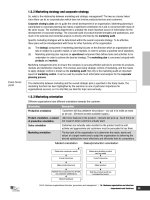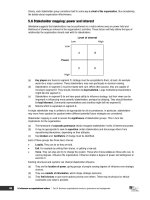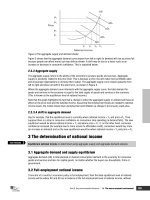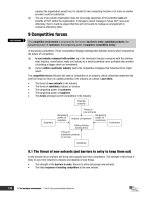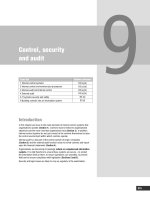acca paper f1 accountant in business phần 1 docx
Bạn đang xem bản rút gọn của tài liệu. Xem và tải ngay bản đầy đủ của tài liệu tại đây (6.25 MB, 45 trang )
S
T
U
D
Y
T
E
X
T
PAPER F1
ACCOUNTANT IN BUSINESS
In this edition approved by ACCA
x We ddiscuss the bbest strategies for studying for ACCA exams
x We h
highlight the mmost important elements in the syllabus and the kkey skills you will need
x We s
signpost how each chapter links to the syllabus and the study guide
x We p
provide lots of eexam focus points demonstrating what the examiner will want you to do
x We e
emphasise key points in regular ffast forward summaries
x We ttest your knowledge of what you've studied in qquick quizzes
x We eexamine your understanding in our eexam question bank
x We rreference all the important topics in our ffull index
BPP's i-Learn and i-Pass products also support this paper.
FOR EXAMS IN DECEMBER 2009 AND JUNE 2010
ii
First edition 2007
Third edition June 2009
ISBN 9780 7517 6361 4
(Previous ISBN 9780 7517 4720 1)
British Library Cataloguing-in-Publication Data
A catalogue record for this book
is available from the British Library
Published by
BPP Learning Media Ltd
BPP House, Aldine Place
London W12 8AA
www.bpp.com/learningmedia
Printed in the United Kingdom
Your learning materials, published by BPP
Learning Media Ltd, are printed on paper
sourced from sustainable, managed forests.
All our rights reserved. No part of this publication may be
reproduced, stored in a retrieval system or transmitted, in
any form or by any means, electronic, mechanical,
photocopying, recording or otherwise, without the prior
written permission of BPP Learning Media Ltd.
We are grateful to the Association of Chartered Certified
Accountants for permission to reproduce past
examination questions. The suggested solutions in the
exam answer bank have been prepared by BPP Learning
Media Ltd, except where otherwise stated.
©
BPP Learning Media Ltd
2009
Contents iii
Contents
Page
Introduction
How the BPP ACCA-approved Study Text can help you pass v
Studying F1 vii
The exam paper ix
Part A Business organisational structure, governance
and management
1a Business organisation and structure – structure and strategy 3
1b Business organisation and structure – departments and functions 27
2 Information technology and systems 51
3 Influences on organisational culture 65
4 Ethical considerations 85
5 Corporate governance and social responsibility 99
Part B Key environmental influences
6 The macro-economic environment 121
7 The business environment 149
Part C History and role of accounting
8 The role of accounting 181
Part D Specific functions of accounting and internal
financial control
9 Control, security and audit 215
10 Identifying and preventing fraud 241
Part E Leading and managing individuals and teams
11 Leading and managing people 261
12 Individuals, groups and teams 287
13 Motivating individuals and groups 307
Part F Recruiting and developing effective employees
14 Personal effectiveness and communication 327
15 Recruitment and selection 351
16 Diversity and equal opportunities 375
17 Training and development 385
18 Performance appraisal 405
Exam question bank 421
Exam answer bank
427
Index
433
Review form and free prize draw
iv
A note about copyright
Dear Customer
What does the little © mean and why does it matter?
Your market-leading BPP books, course materials and e-learning materials do not write and update
themselves. People write them: on their own behalf or as employees of an organisation that invests in this
activity. Copyright law protects their livelihoods. It does so by creating rights over the use of the content.
Breach of copyright is a form of theft – as well as being a criminal offence in some jurisdictions, it is
potentially a serious breach of professional ethics.
With current technology, things might seem a bit hazy but, basically, without the express permission of
BPP Learning Media:
x Photocopying our materials is a breach of copyright
x Scanning, ripcasting or conversion of our digital materials into different file formats, uploading them
to facebook or emailing them to your friends is a breach of copyright
You can, of course, sell your books, in the form in which you have bought them – once you have finished
with them. (Is this fair to your fellow students? We update for a reason.) But the e-products are sold on a
single user licence basis: we do not supply ‘unlock’ codes to people who have bought them second-hand.
And what about outside the UK? BPP Learning Media strives to make our materials available at prices
students can afford by local printing arrangements, pricing policies and partnerships which are clearly
listed on our website. A tiny minority ignore this and indulge in criminal activity by illegally photocopying
our material or supporting organisations that do. If they act illegally and unethically in one area, can you
really trust them?
Introduction v
How the BPP ACCA-approved Study Text can help you
pass – AND help you with your Practical Experience
Requirement!
NEW FEATURE – the PER alert!
Before you can qualify as an ACCA member, you do not only have to pass all your exams but also fulfil a
three year practical experience requirement (PER). To help you to recognise areas of the syllabus that
you might be able to apply in the workplace to achieve different performance objectives, we have
introduced the ‘PER alert’ feature. You will find this feature throughout the Study Text to remind you that
what you are learning to pass your ACCA exams is equally useful to the fulfilment of the PER
requirement.
Tackling studying
Studying can be a daunting prospect, particularly when you have lots of other commitments. The
different features of the text, the purposes of which are explained fully on the Chapter features page, will
help you whilst studying and improve your chances of exam success.
Developing exam awareness
Our Texts are completely focused on helping you pass your exam.
Our advice on Studying F1 outlines the content of the paper and the necessary skills the examiner
expects you to demonstrate.
Exam focus points are included within the chapters to provide information about skills that you will need
in the exam and reminders of important points within the specific subject areas.
Using the Syllabus and Study Guide
You can find the syllabus, Study Guide and other useful resources for F1 on the ACCA web site:
www.accaglobal.com/students/study_exams/qualifications/acca_choose/acca/fundamentals/ab
The Study Text covers all aspects of the syllabus to ensure you are as fully prepared for the exam as
possible.
Testing what you can do
Testing yourself helps you develop the skills you need to pass the exam and also confirms that you can
recall what you have learnt.
We include Exam-style Questions – lots of them - both within chapters and in the Exam Question Bank,
as well as Quick Quizzes at the end of each chapter to test your knowledge of the chapter content.
vi Introduction
Chapter features
Each chapter contains a number of helpful features to guide you through each topic.
Topic list
Topic list Syllabus reference
Tells you what you will be studying in this chapter and the
relevant section numbers, together with the ACCA
syllabus references.
Introduction
Puts the chapter content in the context of the syllabus as
a whole.
Study Guide
Links the chapter content with ACCA guidance.
Exam Guide
Highlights how examinable the chapter content is likely to
be and the ways in which it could be examined.
Summarises the content of main chapter headings,
allowing you to preview and review each section easily.
Examples
Demonstrate how to apply key knowledge and
techniques.
Key terms
Definitions of important concepts that can often earn you
easy marks in exams.
Exam focus points
Provide information about skills you will need in the exam
and reminders of important points within the specific
subject area.
Formula to learn
Formulae that are not given in the exam but which have to
be learnt.
This is a new feature that gives you a useful indication of
syllabus areas that closely relate to performance
objectives in your PER.
Question
Give you essential practice of techniques covered in the
chapter.
Case Study
Provide real world examples of theories and techniques.
Chapter Roundup
A full list of the Fast Forwards included in the chapter,
providing an easy source of review.
Quick Quiz
A quick test of your knowledge of the main topics in the
chapter.
Exam Question Bank
Found at the back of the Study Text with more
comprehensive chapter questions.
FA
S
T F
O
RWAR
D
Introduction vii
Studying F1
1 What the paper is about
The overall aim of the Accountant in Business syllabus is to introduce accountancy firmly in its
context as a central business function. This encompasses:
x Business structure and management
x Environmental analysis and influences
x Accounting and its relationship with other business functions
x Regulation and the accounting profession
x Audit and internal control
x People management issues
The six broad areas of the syllabus are not given specific weightings, indicating that questions on
the examination paper could be drawn from any source. The syllabus areas are as follows.
x Business organisation structure, governance and management
How the organisation is structured and governed. You will study organisational concepts,
the influence of organisational culture and the role of IT and the importance of effective
information systems. Ethics, governance and social responsibility are also important here.
x Key environmental influences
It is important to understand the macro-economic environment within which a business
operates. The PEST framework provides a useful way to analyse direct environmental
influences.
x History and role of accounting
The purpose of the accounting function merits specific consideration in this syllabus and
this section provides a theoretical basis for the detailed analysis of the accounting function
which follows.
x Specific functions of accounting and internal financial control
This section of the syllabus examines the detailed aspects of accounting systems in a
typical organisation, internal financial control and audit. This function plans and monitors
business performance, and also has a key role to play in detecting and preventing fraud.
x Leading and managing individuals and teams
It is important to understand how the management and motivation of staff aligns with wider
organisational objectives. This section of the syllabus explores both theoretical and practical
aspects of what is generally termed 'people management'.
x Recruiting and developing effective employees
The recruitment and development of employees is another important organisational activity.
Ensuring that employees develop constructive relationships and work effectively is a way of
making sure that they contribute towards organisational objectives.
2 What's required
This exam tests two intellectual levels in its questions: knowledge and comprehension, and
application and analysis. You will need to be familiar with the basic models and theories associated
with organisations, business functions and people management, and be able to apply these basic
ideas to questions where ideas are explored.
There are several broad question types:
x 'True or false' for one mark
x Multiple choice questions with 'choose one answer from four options' for two marks
x Multiple choice questions with 'choose one answer from three options' for one mark
x Multiple choice questions with 'choose one answer from two options' for one mark
Despite the fact that the questions are all short ones carrying only one or two marks, it is still
possible for higher skills of comprehension to be tested.
viii Introduction
Note also that exam questions will not include country-specific questions. There will also be no
negative questions such as 'which of the following is not…?' However, the examiner has stated
that these types of questions are useful for revision purposes and so these types of questions are
included in our materials.
3 How to pass
Cover the whole syllabus
The exam consists of 40 two mark questions and 10 one mark questions. With 50 questions at his
disposal, the examiner has plenty of scope to test all major areas of the syllabus. For this reason it
is not advisable to study the syllabus selectively, as the format of the exam enables all topics to be
tested in some way. The pass mark for F1 is 50%.
Practise, practise and practise again!
We cannot emphasise enough the importance of practising questions throughout your studies.
Make sure that you attempt the questions within the Study Text chapters, the quick quizzes at the
end of each chapter and the questions in the question bank at the back of the Text. When you are
revising for the exam you should practise more questions using the Practice and Revision Kit. The
i-Pass CD contains further questions for extra practice.
Introduction ix
The exam paper
Format of the paper
Number of
marks
40 two mark questions 80
10 one mark questions 10
90
Time allowed: 2 hours
Pass mark: 50%
Guidance
The syllabus is assessed by a two-hour paper or computed-based examination. There will be either eight
or nine questions on each of the generic syllabus areas in every examination. Questions will test
knowledge and some comprehension or application of this knowledge. The examinations will consist of 40
two mark questions and 10 one mark questions.
The detailed syllabus is shown on page x and the ACCA's study guide is shown at the beginning of each
chapter.
The ACCA's website is a useful source of other information relating to the F1 exam. For example, the
examiner writes a report on how students have performed after each exam sitting. Visit the 'exam paper
resources' section on www.accaglobal.com/students/study_exams/
x Introduction
Detailed syllabus
A Business organisation structure, governance and management
1 The business organisation and its structure
2 The formal and informal business organisation
3 Organisational culture in business
4 Stakeholders of business organisations
5 Information technology and information systems in business
6 Committees in the business organisation
7 Business ethics and ethical behaviour
8 Governance and social responsibility in business
B Key environmental influences and constraints on business and accounting
1 Political and legal factors
2 Macro-economic factors
3 Social and demographic factors
4 Technological factors
5 Competitive factors
C History and role of accounting in business
1 The history and function of accounting in business
2 Law and regulation governing accounting
3 Financial systems, procedures and IT applications
4 The relationship between accounting and other business functions
D Specific functions of accounting and internal financial control
1 Accounting and finance functions within business
2 Internal and external auditing and their functions
3 Internal financial control and security within business organisations
4 Fraud and fraudulent behaviour and their prevention in business.
E Leading and managing individuals and teams
1 Leadership, management and supervision
2 Individual and group behaviour in business organisations
3 Team formation, development and management
4 Motivating individuals and groups
F Recruiting and developing effective employees
1 Recruitment and selection, managing diversity, and equal opportunity.
2 Techniques for improving personal effectiveness at work and their benefits
3 Features of effective communication
4 Training, development, and learning in the maintenance and improvement of business
performance
5 Review and appraisal of individual performance
1
Business organisational
structure, governance and
management
P
A
R
T
A
2
3
Business
organisation and
structure – structure
and strategy
Introduction
Organisations develop out of the need to co-ordinate work, but this can be
achieved in different ways. In this chapter we identify the different types of
organisation (Section 1).
There are various influences upon organisational structure (Section 2). Most
firms have some sort of organisation hierarchy reflecting the levels of
strategy-making (Section 3). We can see the strategic apex (eg Board of
Directors) at the top, through ranks of middle managers to the operating core
where the work is done.
Topic list Syllabus reference
1 Types of organisation A1 (a)
2 Organisational structure A1 (b)(f)
3 Levels of strategy in the organisation A1 (d)
1a: Business organisation and structure ~ Part A Business organisational structure, governance and management
4 – structure and strategy
Study guide
Intellectual level
A1 The business organisation and its structure
(a) Identify the different types of organisation: 1
(i) Commercial
(ii) Not-for-profit
(iii) Public sector
(iv) Non-governmental organisations
(v) Cooperatives
(b) Describe the different ways in which organisations may be structured:
entrepreneurial, functional, matrix, divisional, departmental, by geographical
area and by product.
1
(d) Explain the characteristics of the strategic, tactical and operational levels in
the organisation in the context of the Anthony hierarchy.
1
(f) Explain basic organisational structure concepts: 1
(i) Separation of direction and management
(ii) Span of control and scalar chain
(iii) Tall and flat organisations
Exam guide
This chapter lays the foundation for an understanding of what organisations are, what they do and how
they do it. Organisational structure concepts (Section 2) represent a higher level of knowledge. According
to the Study Guide you must be able to apply knowledge to exam questions.
Part A Business organisational structure, governance and management ~ 1a: Business organisation and structure
– structure and strategy
5
1 Types of organisation
1.1 What all organisations have in common
An organisation is: 'a social arrangement which pursues collective goals, which controls its own
performance and which has a boundary separating it from its environment'.
Here are some examples of organisations.
x A multinational car manufacturer (eg Ford) x A local authority
x An accountancy firm (eg Ernst and Young) x A trade union (eg Unison)
x A charity (eg Oxfam) x An army
The common characteristics of organisations are as follows.
(a) Organisations are preoccupied with performance, and meeting or improving their standards.
(b) Organisations contain formal, documented systems and procedures which enable them to control
what they do.
(c) Different people do different things, or specialise in one activity.
(d) They pursue a variety of objectives and goals.
(e) Most organisations obtain inputs (eg materials), and process them into outputs (eg for others to
buy).
1.2 Why do organisations exist?
Organisations can achieve results which individuals cannot achieve by themselves.
(a) Organisations overcome people's individual limitations, whether physical or intellectual.
(b) Organisations enable people to specialise in what they do best.
(c) Organisations save time, because people can work together or do two aspects of a different task at
the same time.
(d) Organisations accumulate and share knowledge.
(e) Organisations enable synergy: by bringing together two individuals their combined output will
exceed their output if they continued working separately.
In brief, organisations enable people to be more productive.
1.3 How organisations differ
The common elements of organisations were described in paragraph 1.1, but organisations also differ in
many ways. Here are some possible differences.
(a) Ownership
Some organisations are owned by private owners or shareholders. These are private sector
organisations. Public sector organisations are owned by the government.
(b) Control
Some organisations are controlled by the owners themselves but many are controlled by people
working on their behalf. Some are indirectly controlled by government-sponsored regulators.
(c) Activity
What organisations actually do can vary enormously. They could be manufacturing organisations,
for example, or they could be a healthcare service.
(d) Profit or non-profit orientation
Some businesses exist to make a profit. Others, for example the army, are not profit orientated.
(e) Legal status
Organisations may be limited companies or partnerships.
Key term
1a: Business organisation and structure ~ Part A Business organisational structure, governance and management
6 – structure and strategy
(f) Size
The business may be a small family business or a multinational corporation.
(g) Sources of finance
Business can raise finance by borrowing from banks or government funding or issuing shares.
(h) Technology
Businesses have varying degrees of technology use. For example, computer firms will have high
use of technology but a corner shop will have very low use.
1.4 What the organisation does
Organisations do many different types of work. Here are some examples.
Industry Activity
Agriculture
Producing and processing food
Manufacturing
Acquiring raw materials and, by the application of labour and
technology, turning them into a product (eg a car)
Extractive/raw materials
Extracting and refining raw materials (eg mining)
Energy
Converting one resource (eg coal) into another (eg electricity)
Retailing/distribution
Delivering goods to the end consumer
Intellectual production Producing intellectual property eg software, publishing, films, music
etc
Service industries
These include retailing, distribution, transport, banking, various
business services (eg accountancy, advertising) and public services
such as education, medicine
1.5 Profit vs non-profit orientation
An important difference in the list above is between profit orientated ('commercial') and non profit
orientated organisations. The basic difference in outlook is expressed in the diagram below. Note the
distinction between primary and secondary goals. A primary goal is the most important: the other goals
support it.
1.6 Private vs public sector
Private sector: organisations not owned or run by central or local government, or government agencies
Public sector: organisation owned or run by central or local government or government agencies
Key terms
Part A Business organisational structure, governance and management ~ 1a: Business organisation and structure
– structure and strategy
7
1.7 Private sector businesses
A business organisation exists to make a profit. In other words, the costs of its activities should be less
than the revenues it earns from providing goods or services. Profits are not incidental to its activities but
the driving factor.
Business organisations come in all different shapes and sizes, and there is a choice of legal structure.
1.7.1 Legal status
Someone setting up a business can choose to go into business alone, take on one or more partners who
also share the profits of the business, or set up a limited company.
1.7.2 Limited companies
A limited company has a separate legal personality from its owners (shareholders). The shareholders
cannot normally be sued for the debts of the business unless they have given some personal guarantee.
Their risk is generally restricted to the amount that they have invested in the company when buying the
shares. This is called limited liability.
Whereas sole traderships and partnerships are normally small business, limited company status is used
for businesses of any size.
The ownership and control of a limited company are legally separate even though they may be vested in
the same individual or individuals.
(a) Shareholders are the owners but have limited rights, as shareholders, over the day to day running
of the company. They provide capital and receive a return. Shareholders could be large institutional
investors (such as insurance companies and pension funds), private individuals, or employees.
(b) Directors are appointed by shareholders to run the company. In the UK, the board of directors
controls management and staff, and is accountable to the shareholders, but it has responsibilities
towards both groups – owners and employees alike.
(i) Executive directors participate in the daily operations of the organisation.
(ii) Non-executive directors are invited to join in an advisory capacity, usually to bring their
particular skills or experience to the discussions of the board to exercise some overall
guidance.
(c) Operational management usually consists of career managers who are recruited to operate the
business, and are accountable to the board.
1.7.3 Types of limited company
In the UK, limited companies come in two types: private limited companies (eg X Limited) and public
limited companies (eg X plc). They differ as follows.
(a) Number of shareholders. Most private companies are owned by only a small number of
shareholders. Public companies generally are owned by a wider proportion of the investing public.
(b) Transferability of shares. Shares in public companies can be offered to the general public. In
practice this means that they can be traded on a stock exchange. Shares in private companies, on
the other hand, are rarely transferable without the consent of the shareholders.
(c) Directors as shareholders. The directors of a private limited company are more likely to hold a
substantial portion of the company's shares than the directors of a public company.
Key terms
1a: Business organisation and structure ~ Part A Business organisational structure, governance and management
8 – structure and strategy
(d) Source of capital
(i) A private company's share capital will normally be provided from three sources.
– The founder or promoter
– Business associates of the founder or employer
– Venture capitalists
(ii) A public company's share capital, in addition, can be raised from the public directly, or
through institutional investors, using recognised markets.
Many companies start in a small way, often as family businesses which operate as private companies,
then grow to the point where they become public companies and can invite investors to subscribe for
shares. The new capital thus made available enables the firm to expand its activities and achieve the
advantages of large scale operation.
1.7.4 Advantages and disadvantages of limited companies
Advantages
x More money available for investment.
x Reduces risk for investors thanks to limited liability.
x Separate legal personality. A company can own property, make contracts etc.
x Ownership is legally separate from control. Investors need not get involved in operations.
x No restrictions on size. Some companies have millions of shareholders.
x Flexibility. Capital and enterprise can be brought together.
Disadvantages
x Legal compliance costs. Because of limited liability, the financial statements of most limited
companies have to be audited, and then published for shareholders.
x Shareholders have little practical power, other than to sell their shares to a new group of
managers, although they can vote to sack the directors.
1.7.5 Co-operative societies and mutual associations
Co-operatives are businesses owned by their workers or customers, who share the profits. Here are some
of the features they have in common.
x Open membership
x Democratic control (one member, one vote)
x Distribution of the surplus in proportion to purchases
x Promotion of education.
Case Study
A major example of a co-operative in the UK is the Co-operative Retail Store network. In addition there is
the Co-operative Wholesale Society and the Co-operative Bank. Another example is the John Lewis
Partnership.
Mutual associations are similar to co-operatives in that they are 'owned' by their members rather than
outside investors.
(a) Some financial companies used to be mutual associations. However, building societies in the UK
such as the Abbey National and the Halifax converted from being mutual associations to being
banks. The Nationwide Building Society has held out against this, so far citing the lower interest
rates it can offer to borrowers.
(b) Credit unions are examples of mutual associations. They are financial institutions owned and
controlled by their members.
Part A Business organisational structure, governance and management ~ 1a: Business organisation and structure
– structure and strategy
9
Question
Legal form
Florence Nightingale runs a successful and growing small business as a sole trader. She wishes to expand
the business and has her eyes on Scutari Ltd, a small private limited company in the same line. After the
acquisition, she runs the two businesses as if they were one operation making no distinction between
them. What is the legal form of the business she is running?
Answer
This is quite a tricky question. For example, if suppliers have contracts with Scutari Ltd, the contract is
with the company, and Florence is not legally liable for the company's debts. If their contracts are with
Florence, then they are dealing with her personally. Florence has to make a choice.
(a) She can run the entire business as a sole trader, in which case Scutari Ltd's assets must be
transferred to her
(b) She can run her entire business as a limited company, in which case she would contribute the
assets of her business as capital to the company
(c) She can ensure that the two business are legally distinct in their assets, liabilities, income and
expenditure.
1.8 The public sector
The public sector comprises all organisations owned and run by the government and local government.
Here are some examples.
x The armed forces x Government departments
x Most schools and universities
Public sector organisations have a variety of objectives.
x The Benefits Agency administers part of the social security system.
x The Post Office makes a profit from mail services, although it does have a social function too.
1.8.1 Key characteristics of the public sector
(a) Accountability, ultimately, to Parliament
(b) Funding. The public sector can obtain funds in three main ways.
(i) Raising taxes
(ii) Making charges (eg for prescriptions)
(iii) Borrowing
(c) Demand for services. There is a relationship between the price charged for something and the
'demand'. In the public sector demand for many services is practically limitless.
(d) Limited resources. Despite the potentially huge demand for public services, constraints on
government expenditure mean that resources are limited and that demand cannot always be met.
1.8.2 Advantages
(a) Fairness. The public sector can ensure that everyone has access to health services.
(b) Filling the gaps left by the private sector, by providing public goods such as streetlighting.
(c) Public interest. Governments once believed the public interest was best served if the state ran
certain services.
(d) Economies of scale. Costs can be spread if everything is centralised.
1a: Business organisation and structure ~ Part A Business organisational structure, governance and management
10 – structure and strategy
(e) Cheaper finance. Taxes or borrowing backed by government guarantees might be cheaper than
borrowing at commercial rates.
(f) Efficiency. The public sector is sometimes more efficient than the private sector. The UK's NHS,
despite its well publicised problems, has lower administration costs and serves more of the
population than the private sector does in the US.
1.8.3 Disadvantages
(a) Accountability. Inefficiency may be ignored as taxpayers bear losses.
(b) Interference. Politicians may not be familiar with the operation of a business and yet political
pressures and indecision may influence adversely the decision making process. Pressures to get
elected may lead to the deferral of necessary but unpopular decisions.
(c) Cost. There can be conflict between economy of operation and adequacy of service. The public will
demand as perfect a service as possible but will not wish to bear the cost involved.
1.9 Non-governmental organisations
A non-governmental organisation (NGO) is an independent voluntary association of people acting together
for some common purpose (other than achieving government office or making money).
Non-governmental organisations (NGOs) are bodies which are not directly linked with national
government. The description 'NGO' generally applies to groups whose primary aim is not a commercial
one, but within this the term is applied to a diverse range of activities, aimed at promoting social, political
or environmental change.
Case Study
The UK has a significant number of NGOs providing information on conservation matters. The Farming
and Wildlife Advisory Service, for example, is a non-government organisation which provides farmers with
practical advice on managing farm operations in order to support wildlife, landscape, archaeology and
other conservation issues.
NGOs need to engage in fund raising and mobilisation of resources (donations, volunteer labour,
materials). This process may require quite complex levels of organisation. The following are some
organisational features of NGOs.
x Staffing by volunteers as well as full time employees
x Finance from grants or contracts
x Skills in advertising and media relations
x Some kind of national 'headquarters'
x Planning and budgeting expertise
It can be seen, therefore, that NGOs may need to possess an efficient level of organisation structure, much
in the same way as a traditional commercial undertaking.
FA
S
T F
O
RWAR
D
Part A Business organisational structure, governance and management ~ 1a: Business organisation and structure
– structure and strategy
11
2 Organisational structure
2.1 Components of the organisation
Mintzberg believes that all organisations can be analysed into five components, according to how they
relate to the work of the organisation, and how they prefer to co-ordinate.
Component Job Preferred means of co-ordination
Strategic apex
Ensures the organisation follows its
mission. Manages the organisation's
relationship with the environment.
Direct supervision (especially in small
businesses)
Operating core People directly involved in the process of
obtaining inputs, and converting them
into outputs
Mutual adjustment; standardisation of
skills
Middle line
Converts the desires of the strategic apex
into the work done by the operating core
Standardisation of outputs (results)
Technostructure
x Analysers determine the best way of
doing a job
x Planners determine outputs (eg
goods must achieve a specified level
of quality)
x Personnel analysts standardise skills
(eg training programmes)
Standardisation of work processes or
outputs
Support staff
Ancillary services such as public
relations, legal counsel, the cafeteria.
Support staff do not plan or standardise
production. They function independ-
ently of the operating core.
Mutual adjustment
In most organisations, tasks and people are grouped together in some rational way: on the basis of
specialisation, say, or shared technology or customer base. This is known as departmentation. Different
patterns of departmentation are possible, and the pattern selected will depend on the individual
circumstances of the organisation.
FA
S
T F
O
RWAR
D
1a: Business organisation and structure ~ Part A Business organisational structure, governance and management
12 – structure and strategy
Organisations can be departmentalised on a functional basis (with separate departments for production,
marketing, finance etc), a geographical basis (by region, or country), a product basis (eg worldwide
divisions for product X, Y etc), a brand basis, or a matrix basis (eg someone selling product X in country
A would report to both a product X manager and a country A manager). Organisation structures often
feature a variety of these types, as hybrid structures.
2.2 Functional departmentation
Functional organisation involves grouping together people who do similar tasks. Primary functions in a
manufacturing company might be production, sales, finance, and general administration. Sub-
departments of marketing might be market research, advertising, PR and so on.
Advantages include:
(a) Expertise is pooled thanks to the division of work into specialist areas.
(b) It avoids duplication (eg one management accounts department rather than several) and enables
economies of scale.
(c) It facilitates the recruitment, management and development of functional specialists.
(d) It suits centralised businesses.
Disadvantages include:
(a) It focuses on internal processes and inputs, rather than the customer and outputs, which are what
ultimately drive a business. Inward-looking businesses are less able to adapt to changing demands.
(b) Communication problems may arise between different functions, which each have their own
jargon.
(c) Poor co-ordination, especially if rooted in a tall organisation structure. Decisions by one
function/department involving another might have to be referred upwards, and dealt with at a
higher level, thereby increasing the burdens on senior management.
(d) Functional structures create vertical barriers to information and work flow. Management writer
Peters suggests that customer service requires 'horizontal' flow between functions – rather than
passing the customer from one functional department to another.
2.3 Geographic departmentation
Where the organisation is structured according to geographic area, some authority is retained at Head
Office but day-to-day operations are handled on a territorial basis (eg Southern region, Western region).
Many sales departments are organised territorially.
FA
S
T F
O
RWAR
D
Part A Business organisational structure, governance and management ~ 1a: Business organisation and structure
– structure and strategy
13
There are advantages to geographic departmentation.
(a) There is local decision-making at the point of contact between the organisation (eg a salesperson)
and its customers, suppliers or other stakeholders.
(b) It may be cheaper to establish area factories/offices than to service markets from one location (eg
costs of transportation and travelling may be reduced).
But there are disadvantages too.
(a) Duplication and possible loss of economies of scale might arise. For example, a national
organisation divided into ten regions might have a customer liaison department in each regional
office. If the organisation did all customer liaison work from head office (centralised) it might need
fewer managerial staff.
(b) Inconsistency in methods or standards may develop across different areas.
Board of
Directors
Regional
Board
A
Regional
Board
B
Regional
Board
C
Production
dept
Finance
dept
Personnel
dept
Marketing
and sales
dept
etc etc
etcetcetc
Geo
g
raphic
organisation
2.4 Product/brand departmentation
Some organisations group activities on the basis of products or product lines. Some functional
departmentation remains (eg manufacturing, distribution, marketing and sales) but a divisional manager is
given responsibility for the product or product line, with authority over personnel of different functions.
Advantages include:
(a) Accountability. Individual managers can be held accountable for the profitability of individual
products.
(b) Specialisation. For example, some salespeople will be trained to sell a specific product in which
they may develop technical expertise and thereby offer a better sales service to customers.
(c) Co-ordination. The different functional activities and efforts required to make and sell each product
can be co-ordinated and integrated by the divisional/product manager.
Disadvantages include:
(a) It increases the overhead costs and managerial complexity of the organisation.
(b) Different product divisions may fail to share resources and customers.
A brand is the name (eg 'Persil') or design which identifies the products or services of a manufacturer or
provider and distinguishes them from those of competitors. (Large organisations may produce a number
of different brands of the same basic product, such as washing powder or toothpaste.) Branding brings
the product to the attention of buyers and creates brand recognition, differentiation and loyalty: often
customers do not realise that two 'rival' brands are in fact produced by the same manufacturer.
1a: Business organisation and structure ~ Part A Business organisational structure, governance and management
14 – structure and strategy
(a) Because each brand is packaged, promoted and sold in a distinctive way, the need for
specialisation may make brand departmentation effective. As with product departmentation, some
functional departmentation remains but brand managers have responsibility for the brand's
marketing and this can affect every function.
(b) Brand departmentation has similar advantages/disadvantages to product departmentation.
2.5 Customer departmentation
An organisation may organise its activities on the basis of types of customer, or market segment.
(a) Departmentation by customer is commonly associated with sales departments and selling effort,
but it might also be used by a jobbing or contracting firm where a team of managers may be given
the responsibility of liaising with major customers (eg discussing specifications and completion
dates, quality of work, progress chasing etc).
(b) Many businesses distinguish between business customers and consumers.
Question
Types of organisation
Looking at the 'Product/Brand Organisation' chart following Section 2.4 above, what types of organisation
can you identify, and why are these appropriate for their purposes? What added type of organisation might
this firm use, and in what circumstances?
Answer
x At the head office level, there is functional organisation. This enables standardisation of policy and
activity in key 'staff' or support functions shared by the various divisions.
x At divisional level, there is product/brand organisation. This allows the distinctive culture and
attributes of each product/brand to be addressed in production processes and marketing approach.
x For each product/brand, there is functional organisation, enabling specialist expertise to be directed
at the different activities required to produce, market and distribute a product.
x This firm may further organise its marketing department by customer, if its customer base includes
key (high-value, long-term) customer accounts with diverse service needs, for example.
x It may further organise its sales and distribution departments by geographical area, if the customer
base is internationally or regionally dispersed: local market conditions and values, and logistical
requirements of distribution, can then be taken more specifically into account.




